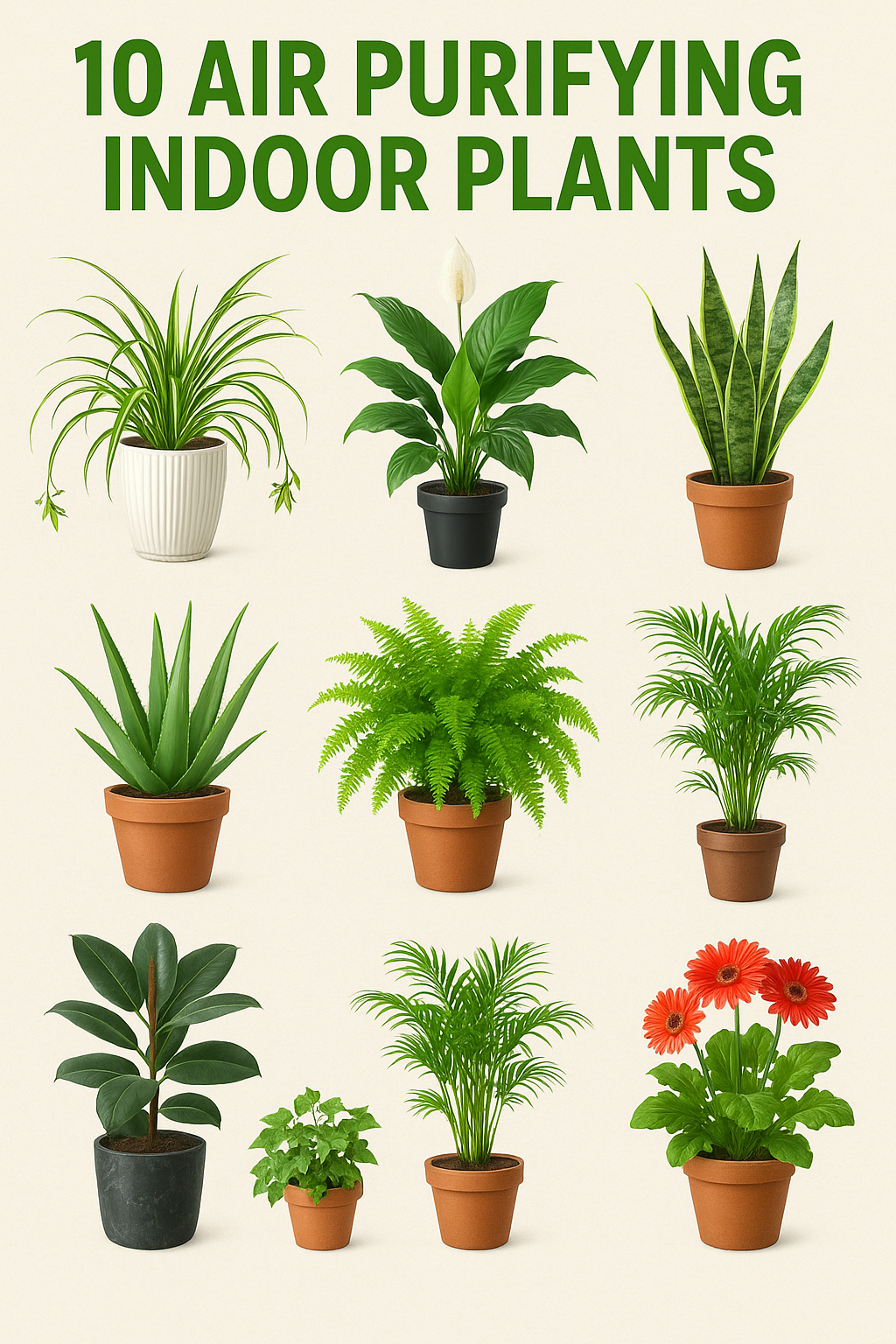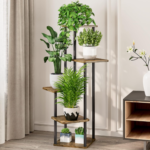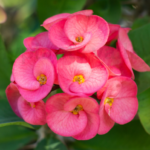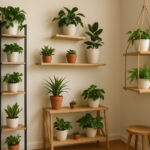Air pollution isn’t just an outdoor problem—it’s inside our homes too. Everyday items like paints, cleaning products, and furniture release toxins into the air. The good news? Nature has a solution! Air-purifying indoor plants act like mini air filters, naturally removing harmful chemicals and improving oxygen levels. These green beauties don’t just clean your air—they boost your mood and make your space more welcoming. Let’s explore 10 amazing indoor plants that help you breathe easier and live healthier.
What Makes Indoor Plants Great Air Purifiers
Indoor plants are more than decorative. They absorb toxins like formaldehyde, benzene, and carbon monoxide through their leaves and roots, converting them into harmless byproducts. Through a process called photosynthesis, they also release oxygen and increase humidity—perfect for dry indoor environments. NASA’s Clean Air Study proved that specific plants can remove up to 87% of air toxins within 24 hours! Whether you live in a city apartment or a small home, adding these plants can make a big difference in your air quality and overall well-being.
1. Spider Plant (Chlorophytum comosum)
The spider plant is one of the easiest air-purifying plants to grow. It effectively removes carbon monoxide, xylene, and formaldehyde from indoor air. Known for its long, arching leaves and baby offshoots, it thrives in indirect sunlight and doesn’t need constant care.
Why it’s great:
- Safe for pets
- Low maintenance
- Grows fast and adapts easily
Water it once a week and watch it brighten your room while purifying your air naturally.
2. Peace Lily (Spathiphyllum)
The peace lily is both elegant and powerful. With its dark green leaves and stunning white flowers, it adds a calming vibe to any room. More importantly, it removes toxins like benzene, formaldehyde, and trichloroethylene.
Care tips:
- Keep in a shaded area with minimal sunlight.
- Water regularly but don’t overwater.
This plant also increases humidity, making it perfect for bedrooms and offices. Just note that it’s toxic to pets if ingested.
3. Snake Plant (Sansevieria trifasciata)
Also known as “Mother-in-Law’s Tongue,” the snake plant is a hardy, stylish air purifier. It converts CO₂ into oxygen at night—unlike most plants that do it during the day. This makes it ideal for bedrooms.
Benefits include:
- Removes benzene, formaldehyde, and xylene.
- Tolerates low light and irregular watering.
Its upright, sword-like leaves make it a modern decor favorite that also helps you sleep better.
4. Aloe Vera
Aloe Vera is famous for its healing gel, but it’s also an incredible air purifier. It eliminates formaldehyde and benzene—chemicals found in paint and cleaning products.
Care guide:
- Prefers bright, indirect sunlight.
- Water sparingly; allow soil to dry between waterings.
Bonus: You can use its gel for burns, skin hydration, and more! It’s a true multipurpose indoor plant that’s both practical and purifying.
5. Boston Fern (Nephrolepis exaltata)
If you love lush greenery, Boston ferns are your go-to. Their feathery fronds effectively remove formaldehyde and xylene from the air.
Care requirements:
- Keep soil consistently moist.
- Mist leaves to maintain humidity.
Boston ferns thrive in cooler spaces with indirect light, making them great for bathrooms or shaded living areas.
6. Areca Palm (Dypsis lutescens)
The Areca Palm, often called the “Butterfly Palm,” is a natural humidifier and toxin remover. It filters xylene, toluene, and carbon monoxide while releasing clean oxygen.
Care instructions:
- Needs bright, filtered light.
- Water moderately to keep soil moist but not soggy.
Its tropical appearance gives any home a resort-like feel while boosting indoor air quality.
7. Rubber Plant (Ficus elastica)
The Rubber Plant’s large, glossy leaves don’t just look good—they’re excellent toxin absorbers. It removes formaldehyde and enhances oxygen production.
Care routine:
- Prefers bright, indirect light.
- Wipe leaves regularly to remove dust.
This plant can grow quite tall, so it’s perfect as a natural indoor statement piece that also keeps your air fresh.
8. English Ivy (Hedera helix)
English Ivy is an attractive climber that can be grown in hanging pots or along walls. It removes mold spores and airborne fecal particles, making it ideal for bathrooms.
Care tips:
- Needs moderate sunlight.
- Water when soil feels dry.
This hardy plant is known to reduce allergens in the air, which is great for people with asthma or allergies.
9. Bamboo Palm (Chamaedorea seifrizii)
The Bamboo Palm is another tropical gem that naturally filters air pollutants like formaldehyde and trichloroethylene.
Key features:
- Adds natural moisture to indoor air.
- Loves indirect sunlight and consistent watering.
It’s a bit larger, making it ideal for living rooms or corners that need a green touch and cleaner air.
10. Gerbera Daisy (Gerbera jamesonii)
Gerbera Daisy brings vibrant colors and fresh air to your home. It’s known to remove benzene and trichloroethylene effectively.
Care guide:
- Needs bright sunlight for a few hours daily.
- Water moderately and ensure good drainage.
Beyond air purification, its cheerful flowers lift your mood instantly—perfect for bedrooms, kitchens, or workspaces.
How to Care for Air-Purifying Indoor Plants
- Light: Most indoor plants prefer indirect sunlight. Avoid harsh direct rays.
- Watering: Overwatering kills more plants than neglect. Keep soil moist, not soggy.
- Humidity: Some tropical varieties love misting.
- Cleaning: Wipe leaves to help them absorb toxins better.
- Fertilizer: Feed monthly during the growing season for best results.
Best Placement Ideas for Indoor Air Plants
Placing plants strategically maximizes their air-purifying benefits.
- Bedroom: Snake plant, peace lily, or aloe vera for better sleep.
- Living Room: Areca palm or rubber plant for large spaces.
- Bathroom: English ivy or Boston fern for humidity control.
- Office Desk: Spider plant or gerbera daisy for a productivity boost.
These placements ensure you get both fresh air and beautiful decor throughout your home.
Conclusion
Adding air-purifying plants to your home isn’t just trendy—it’s a health investment. They naturally cleanse your indoor environment, boost oxygen, and bring life to every corner. Whether you’re a seasoned plant lover or just starting, these 10 plants are easy to grow and maintain. Start small and enjoy the fresh, toxin-free air they create!
FAQs
1. Which indoor plant purifies air the fastest?
The Peace Lily and Snake Plant are among the fastest air purifiers.
2. Are air-purifying plants safe for pets?
Not all are. Choose pet-safe options like the Spider Plant or Areca Palm.
3. Can I keep these plants in low light?
Yes, plants like the Snake Plant and Rubber Plant do well in low light.
4. How many air-purifying plants should I have?
NASA recommends at least one plant per 100 square feet for effective purification.
5. Do these plants help with allergies?
Yes, plants like English Ivy reduce mold and allergens in the air.







